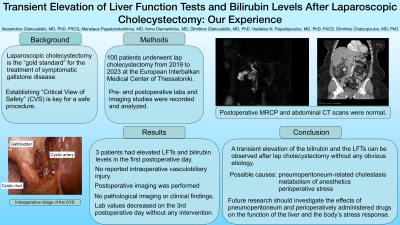Tuesday Poster Session
Category: Biliary/Pancreas
P3429 - Transient Elevation of Liver Function Tests and Bilirubin Levels After Laparoscopic Cholecystectomy: Our Experience
Tuesday, October 29, 2024
10:30 AM - 4:00 PM ET
Location: Exhibit Hall E

Has Audio

Dimitrios Chatzopoulos, MD, PhD
Interbalkan Medical Center
Thessaloniki, Thessaloniki, Greece
Presenting Author(s)
Alexandros Giakoustidis, MD, PhD1, Menelaos Papakonstantinou, MD2, Anna Diamantidou, MD1, Dimitrios Giakoustidis, MD, PhD1, Vasileios N. Papadopoulos, MD, PhD2, Dimitrios Chatzopoulos, MD, PhD1
1Interbalkan Medical Center, Thessaloniki, Thessaloniki, Greece; 2Papageorgiou General Hospital, Thessaloniki, Thessaloniki, Greece
Introduction: Laparoscopic cholecystectomy constitutes the current “gold standard” treatment of symptomatic gallstone disease. In order to avoid intraoperative vasculobiliary injuries it is mandatory to establish “critical view of safety”. In case of poor identification of the cystic duct and artery leading to a missed intraoperative injury, patients present with elevated liver function tests (LFTs) or increased bilirubin postoperatively. The aim of this study is to present a series of patients of our institute with elevated liver enzymes and bilirubin after laparoscopic cholecystectomy in the absence of intraoperative injury or any other obvious etiology and to provide a possible explanation of this finding.
Methods: From 2019 to 2023, 100 patients underwent laparoscopic cholecystectomy at the European Interbalcan Medical Center of Thessaloniki utilizing the “critical view of safety” method. We retrospectively collected the intraoperative reports and the pre and postoperative imaging and laboratory studies of the patients included in this series. Postoperative LFTs and bilirubin levels were extracted and the reason for their transient elevation was examined.
Results: From 100 cases of laparoscopic cholecystectomy, no bile duct injuries and one conversion to open surgery were reported. There was one case of duct of Luschka diagnosis, which was successfully managed intraoperatively. In 3 patients elevated LFTs and bilirubin were found on the first postoperative day, which is suggestive of a missed intraoperative injury. All patients were asymptomatic. During the investigatory workup, a triple-phase CT of the liver and/or an MRCP were ordered, but no pathological findings, such as biliary injury, hepatic artery injury or choledocholithiasis, were found. On postoperative day 3, LFTs and bilirubin levels decreased or normalized without any intervention. No postoperative complications were reported.
Discussion: In select cases, a transient increase in LFTs and/or bilirubin may be observed in the early postoperative period after laparoscopic cholecystectomy in the absence of an obvious etiology. A possible interpretation of these findings could involve the pneumoperitoneum or the anesthesia regimens used intra- or perioperatively. The specific cause however remains undetermined and yet to be examined by future studies.
Disclosures:
Alexandros Giakoustidis, MD, PhD1, Menelaos Papakonstantinou, MD2, Anna Diamantidou, MD1, Dimitrios Giakoustidis, MD, PhD1, Vasileios N. Papadopoulos, MD, PhD2, Dimitrios Chatzopoulos, MD, PhD1. P3429 - Transient Elevation of Liver Function Tests and Bilirubin Levels After Laparoscopic Cholecystectomy: Our Experience, ACG 2024 Annual Scientific Meeting Abstracts. Philadelphia, PA: American College of Gastroenterology.
1Interbalkan Medical Center, Thessaloniki, Thessaloniki, Greece; 2Papageorgiou General Hospital, Thessaloniki, Thessaloniki, Greece
Introduction: Laparoscopic cholecystectomy constitutes the current “gold standard” treatment of symptomatic gallstone disease. In order to avoid intraoperative vasculobiliary injuries it is mandatory to establish “critical view of safety”. In case of poor identification of the cystic duct and artery leading to a missed intraoperative injury, patients present with elevated liver function tests (LFTs) or increased bilirubin postoperatively. The aim of this study is to present a series of patients of our institute with elevated liver enzymes and bilirubin after laparoscopic cholecystectomy in the absence of intraoperative injury or any other obvious etiology and to provide a possible explanation of this finding.
Methods: From 2019 to 2023, 100 patients underwent laparoscopic cholecystectomy at the European Interbalcan Medical Center of Thessaloniki utilizing the “critical view of safety” method. We retrospectively collected the intraoperative reports and the pre and postoperative imaging and laboratory studies of the patients included in this series. Postoperative LFTs and bilirubin levels were extracted and the reason for their transient elevation was examined.
Results: From 100 cases of laparoscopic cholecystectomy, no bile duct injuries and one conversion to open surgery were reported. There was one case of duct of Luschka diagnosis, which was successfully managed intraoperatively. In 3 patients elevated LFTs and bilirubin were found on the first postoperative day, which is suggestive of a missed intraoperative injury. All patients were asymptomatic. During the investigatory workup, a triple-phase CT of the liver and/or an MRCP were ordered, but no pathological findings, such as biliary injury, hepatic artery injury or choledocholithiasis, were found. On postoperative day 3, LFTs and bilirubin levels decreased or normalized without any intervention. No postoperative complications were reported.
Discussion: In select cases, a transient increase in LFTs and/or bilirubin may be observed in the early postoperative period after laparoscopic cholecystectomy in the absence of an obvious etiology. A possible interpretation of these findings could involve the pneumoperitoneum or the anesthesia regimens used intra- or perioperatively. The specific cause however remains undetermined and yet to be examined by future studies.
Disclosures:
Alexandros Giakoustidis indicated no relevant financial relationships.
Menelaos Papakonstantinou indicated no relevant financial relationships.
Anna Diamantidou indicated no relevant financial relationships.
Dimitrios Giakoustidis indicated no relevant financial relationships.
Vasileios Papadopoulos indicated no relevant financial relationships.
Dimitrios Chatzopoulos indicated no relevant financial relationships.
Alexandros Giakoustidis, MD, PhD1, Menelaos Papakonstantinou, MD2, Anna Diamantidou, MD1, Dimitrios Giakoustidis, MD, PhD1, Vasileios N. Papadopoulos, MD, PhD2, Dimitrios Chatzopoulos, MD, PhD1. P3429 - Transient Elevation of Liver Function Tests and Bilirubin Levels After Laparoscopic Cholecystectomy: Our Experience, ACG 2024 Annual Scientific Meeting Abstracts. Philadelphia, PA: American College of Gastroenterology.
